People visiting Greece are often curious to see the famous landmarks of Athens. Τhe fascinating Greek capital has enough monuments and sites to keep you busy for several days. Here are some of the most important historical places in Athens Greece.
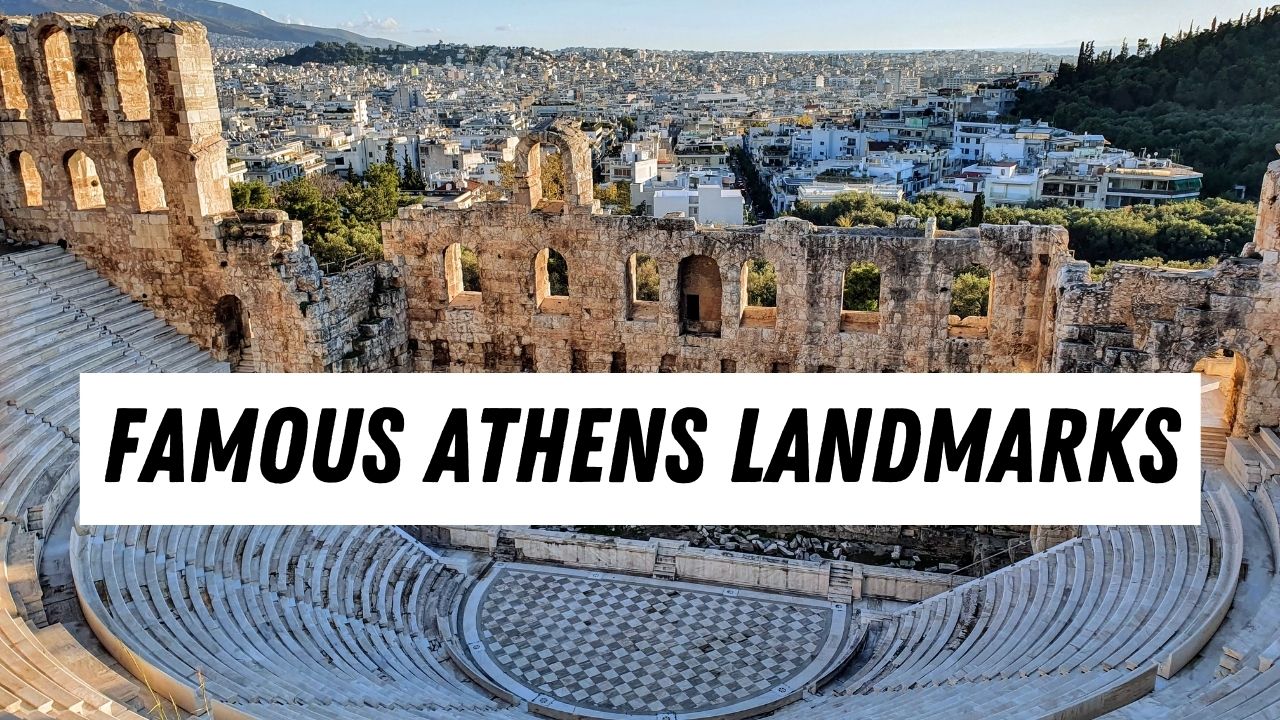
Athens – The Birthplace of Democracy and Cradle of Western Civilization. This ancient city is crammed full of archaeological and religious sites. The most distinguished of these is the Acropolis, a World Heritage Site that towers over Athens and overlooks the city.
Over 500,000 people a year visit the Acropolis, and it is one of the most important archaeological sites in the world. It's by far the most famous of the Athens landmarks, and you can't come to Athens without visiting it.
But what other famous Athens landmarks should you see?
Landmarks and Monuments in Athens
In this guide to the best landmarks in Athens, I've listed 10 incredible places in the center of the city, and thrown in 2 bonus landmarks just on the outskirts.
If you're planning a trip to Athens, be sure to include seeing these Greek monuments and historic places in Athens in your travel itinerary!
10 Top Sites in Athens + 2 Bonus Sites!
- The Parthenon on the Acropolis Hill
- The Temple of the Olympian Zeus
- The Temple of Hephaestus
- Odeon of Herodes Atticus, or Herodion
- Areopagus and the Athens Hills
- The Acropolis Museum
- Dionysiou Areopagitou pedestrian street
- Panathenaic stadium
- Syntagma Square – The Parliament and the Change of the Guards
- The Athens Trilogy
- Panagia Kapnikarea church
- Bonus 1 – The Temple of Poseidon at Sounion
- Bonus 2 – The ancient site of Vravrona (Brauron)

The Parthenon on the Acropolis Hill
Without any doubt, the number one landmark in Athens Greece is the Parthenon on the Acropolis Hill.
The iconic temple is the most famous building, and was built in the 5th century BC to honour the Goddess Athena, the protector of the city of Athens.
The Parthenon is part of the Acropolis complex, which is a UNESCO World Heritage Site. It is one of the most popular ancient sites in the world.
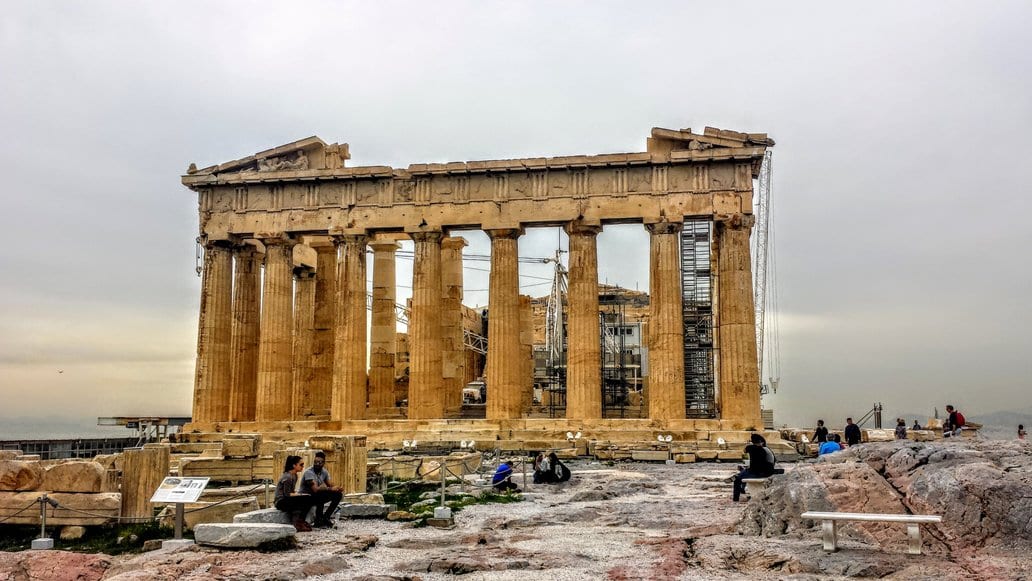
Over 20,000 tons of white marble were used for the construction of the Parthenon. These were transported all the way from Penteli mountain, at the outskirts of Athens. Huge cranes were used to lift the enormous pieces of marble and create the unique monument. Take a look here to see how it was done.
In the past, a 13-metre tall gold-and-ivory statue of Athena was placed up on the Acropolis Hill. Unfortunately, this has most likely been lost forever as loot in the various raids and wars Athens was involved in.

Ancient Athens Acropolis View
Within the Acropolis complex, visitors can see the remains of more temples and other buildings. The Erechtheion, with the famous female statues of the Caryatides, was dedicated to both Athena and Poseidon, the God of the Sea. You can also see the Temple of Athena Nike and the Propylaea, the monumental gate leading to the sacred hill.
When you are up on the hill, walk around, and allow enough time to take in the amazing views of the city of Athens. Most importantly, try to imagine what life was around the area 2,500 years ago. The Acropolis is without doubt one of the most important European landmarks.
Even better, take a guided tour of the Acropolis, which will help you find out more about life in Ancient Greece.
The Temple of Olympian Zeus
The majestic temple of the Olympian Zeus, also known as Olympieion, is only a short walk from the Acropolis. It is one of the largest ancient temples in Greece, and one of the most important ancient Athens attractions.

Its construction originally began in the late 6th century BC, on a site where an older temple existed. It was put on hold for over three centuries, as a result of the change of regime from tyranny to democracy.
Construction works resumed during the early Roman Era. In 131 AD, under Emperor Hadrian’s rule, the colossal temple of Zeus was eventually completed. A gigantic statue of Zeus, made out of gold and ivory, was placed inside the temple, but was subsequently destroyed.

In later centuries, the temple was seriously damaged, and many of the materials were re-used to build other monuments in Athens. Today, out of the original 104 columns, only 15 remain, plus one which has fallen to the ground. Still, the mere size of the columns makes the Temple of Zeus one of the most impressive ancient temples in Greece.
As you are walking around the site, try to find the spots from where you can see the Acropolis – it’s a unique opportunity to include two ancient buildings in Athens in one photo!
The Temple of Hephaestus
The Temple of Hephaestus, or known to the locals as the Hephestion, is a well-preserved Greek temple that was built between 449 and 440 BC. The structure remains standing largely intact due to its Doric peripteral design.
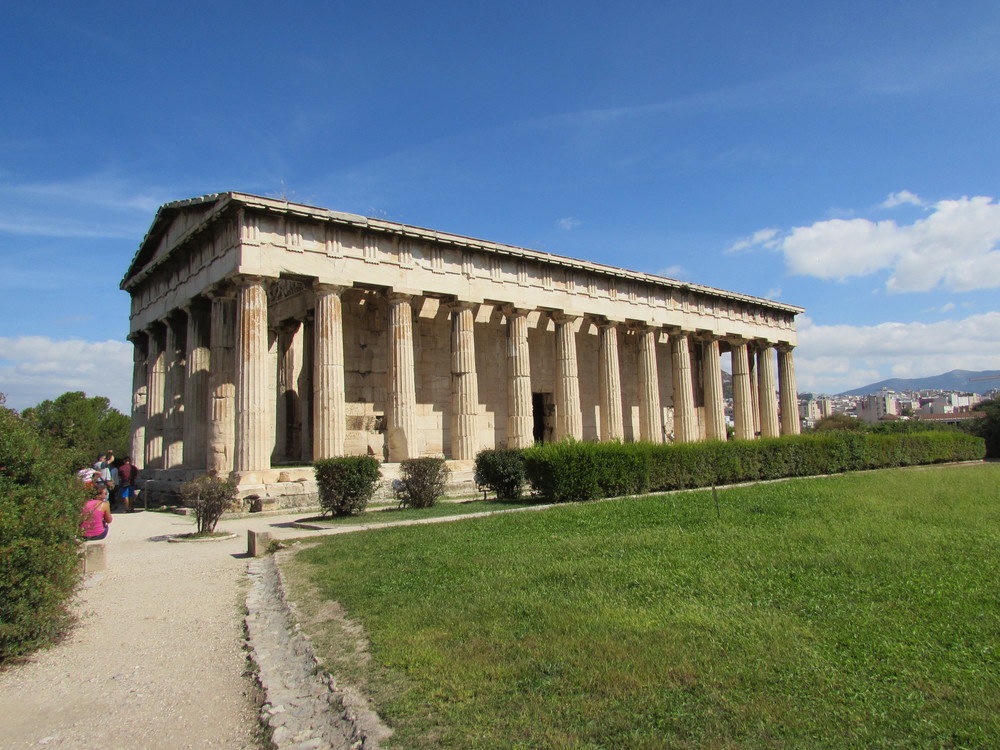
It's located within the Ancient Agora of Athens, as is found at the opposite end of the site than the museum. The ancient writer Pausanias claimed that the temple was built by Hermogenes of Athens, to replace an older Temple of Aphrodite.
The Odeon of Herodes Atticus, or Herodion
As you are going up the Acropolis Hill, look down and you will see a stunning theatre with several thousands of seats. This is the Odeon of Herodes Atticus, also known as Herodion, an impressive landmark of Athens.
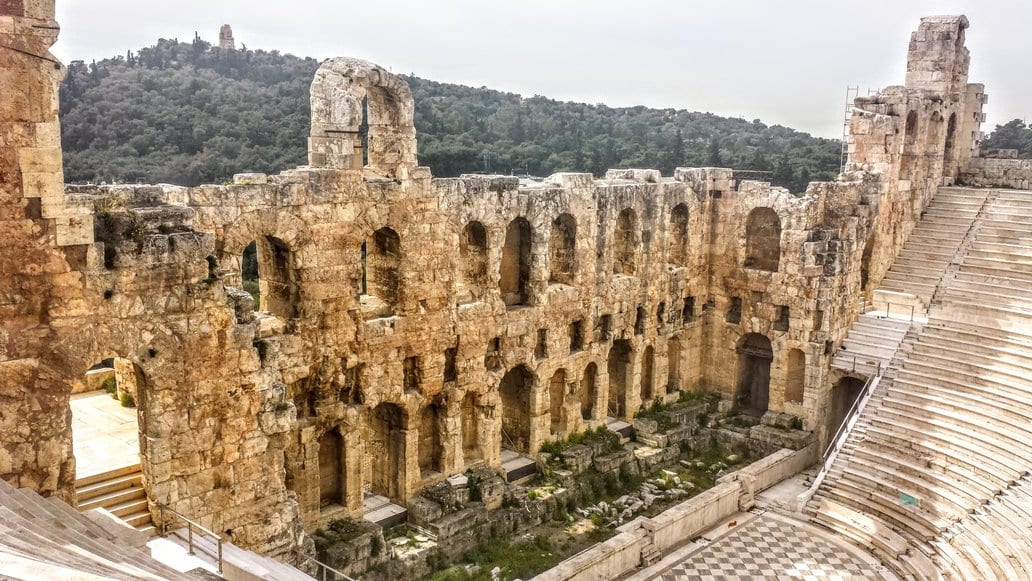
The majestic theatre was originally built between 160 and 174 AD by Herodes Atticus, an Athenian orator and benefactor. It was most likely constructed in memory of his wife, Rigilla. The new Odeon replaced an earlier Odeon in the Ancient Agora of Athens, which had been destroyed.
Over the next century, the Odeon hosted several events, including music, plays and festivals. It was partly destroyed during the Heruli invasion in 267 AD and was later integrated into the walls surrounding the city of Athens.
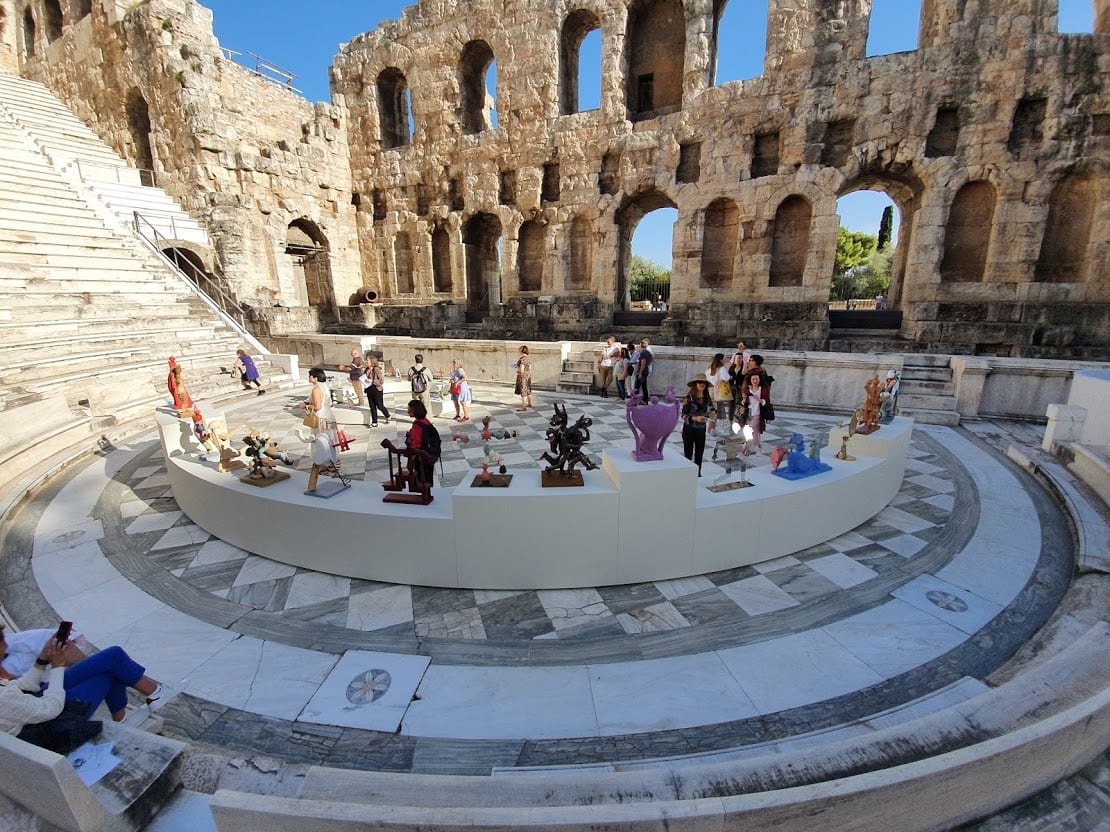
Excavations and restoration work took place in the early 1950s. Since then, the Odeon has been used for numerous shows and performances.
Today, the only way to visit this incredible Athens landmark is during a performance.
If you are in Athens in spring, summer or early autumn, look out for concerts, dance shows or other events in the Herodion. It will be a truly memorable experience of your Athens vacation.
More here: Festivals in Athens.
Areopagus and the Athens Hills
At the foot of the Acropolis and close to the Herodion, you will see a large rock, easily accessible through a metal staircase. This is Areopagus, also known as “Areios Pagos” or “Mars Hill”.

In ancient times, Areios Pagos was the High Court of the city. This is also where Apostle Paul delivered his famous Areopagus Sermon on Christianity, in 51 AD.
Nowadays, the Rock is a popular spot for locals and visitors alike. It offers some of the best views of the Acropolis and the whole of Athens, and is a lovely sunset spot.
Across the street from Areopagus, there are three more hills that are connected with each other: Nymphs Hill, Pnyx Hill and Filopappou or Muses Hill. Not all visitors come to this large green area, which is a real shame, as it offers a fantastic break from the hustle and bustle of the city.
Climb up all the way to the Filopappos Monument for some fantastic views of central Athens. In addition, you can visit the National Observatory of Athens.
The Acropolis Museum
A short walk from the Acropolis lies the emblematic Acropolis Museum, which opened in 2009. It replaced the Old Acropolis Museum, which was up on the Acropolis Hill. Its unique architectural design makes it one of the most modern and famous landmarks in Athens.
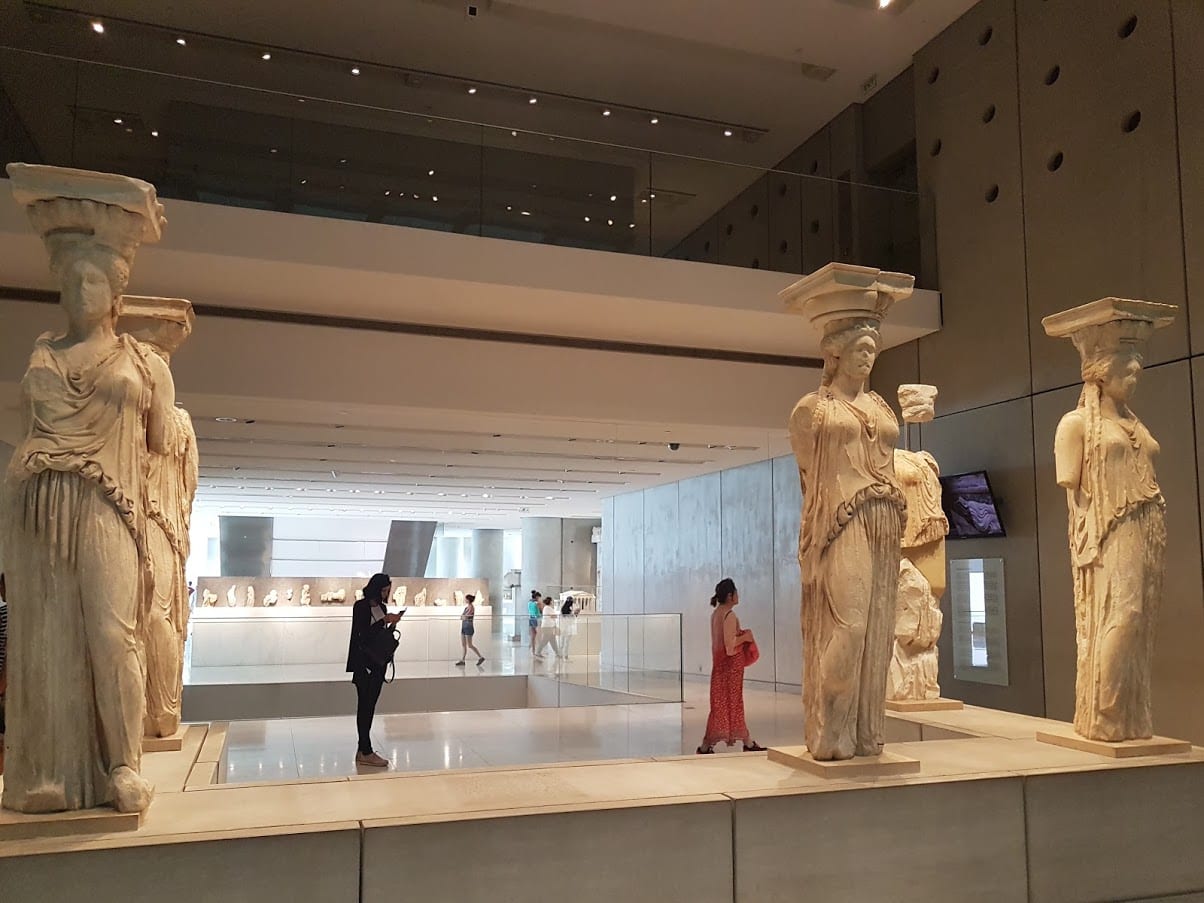
The museum showcases statues, vessels, utensils and other artefacts that were found on the Acropolis Hill during excavations. This is where you can see five of the six original Caryatids statues that held the roof of the Erechtheion temple.
Visiting the museum will give you a better understanding of the Parthenon and the Acropolis. Do not miss the newly opened basement area, where you can see the ruins of ancient mansions.

After the end of your visit, you can have a coffee or meal with a view to the Acropolis. More here: The Acropolis Museum of Athens.
Dionysiou Areopagitou pedestrian street
Not every visitor acknowledges the long pedestrian street running across Ancient Athens. Yet, Dionysiou Areopagitou street is definitely among the landmarks of Athens you should visit.
This area was only pedestrianized in 2003, in anticipation of the 2004 Olympic Games. The street, which changes name to Apostolou Pavlou, connects many of the important historical sites in Athens.
Starting from Acropolis metro, it should take you 20-30 minutes to walk the length of the street and reach Thisseio metro. On your way, you will see many of the Athens landmarks. The Acropolis, Herodion and Areopagus will be on your right, while the Acropolis Museum and the Athens hills will be on your left.
All along the beautiful, wide street you will see buskers and stalls with hand-made jewellery, accessories and souvenirs. There are also a few cafes and restaurants where you can stop for a break, and watch the world go by.
Who knows, perhaps you are following the footsteps of Socrates or Plato!
Panathenaic stadium
This ancient stadium is one of the most impressive famous monuments in Athens. Originally built around 330 BC, it was restored in the 2nd century by Herodes Atticus. It is estimated that, at the time, its capacity was over 50,000 spectators.
Like most other historical sites in Athens Greece, it was gradually abandoned during the Byzantine times.
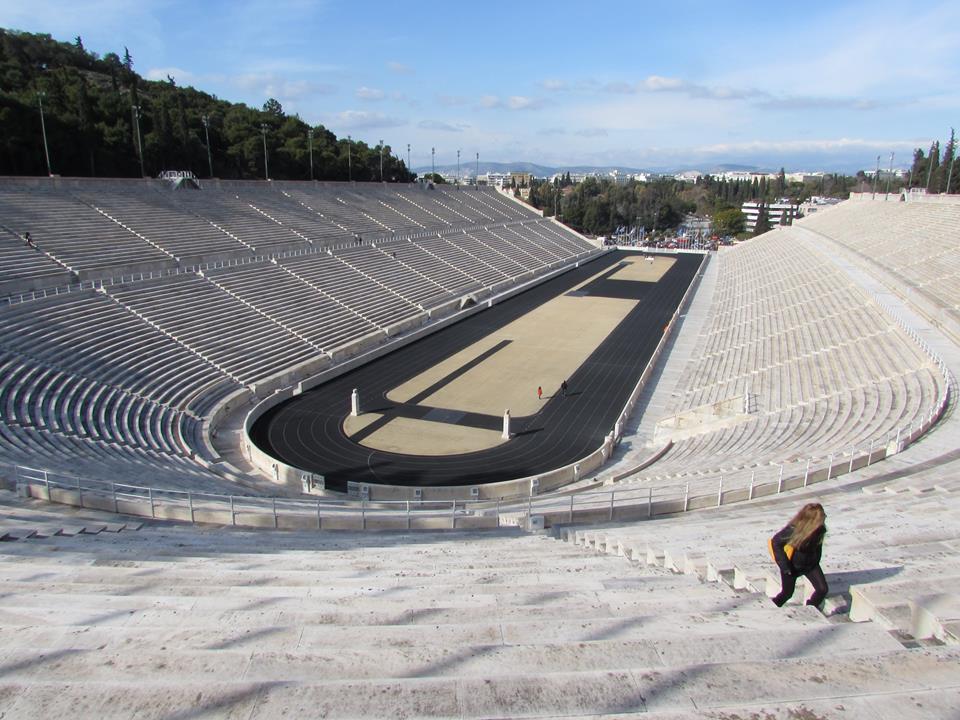
The stadium and the nearby hills were excavated in the late 19th century. With the financial aids of the Greek benefactor George Averoff, the stadium was restored and refurbished. The first modern Olympic Games were held here in 1896.
These days, concerts, ceremonies and major sports events are held at the Panathenaic Stadium. Unlike the Herodion, you can visit the Stadium outside these events.
Words really cannot describe how impressive it is, especially considering that it is the only stadium in the world constructed entirely in marble.
There is also a small museum where you can see posters from previous Olympic Games. Here’s how to visit the Panathenaic Stadium in Athens.
Syntagma Square – The Parliament and the Change of the Guards
Unlike many other European capitals, Athens has rather few neoclassical buildings. The largest of them, and one of the Athens famous landmarks, is the Hellenic Parliament, right on Syntagma Square.
This massive building was originally built as King Otto’s Palace. Its construction was completed in 1847, and it remained a palace until 1909, when it was partly destroyed by a fire.
In the following years, it was briefly used for other purposes, such as a museum and a hospital. It 1929, it was decided that it would host the Parliament of Greece.
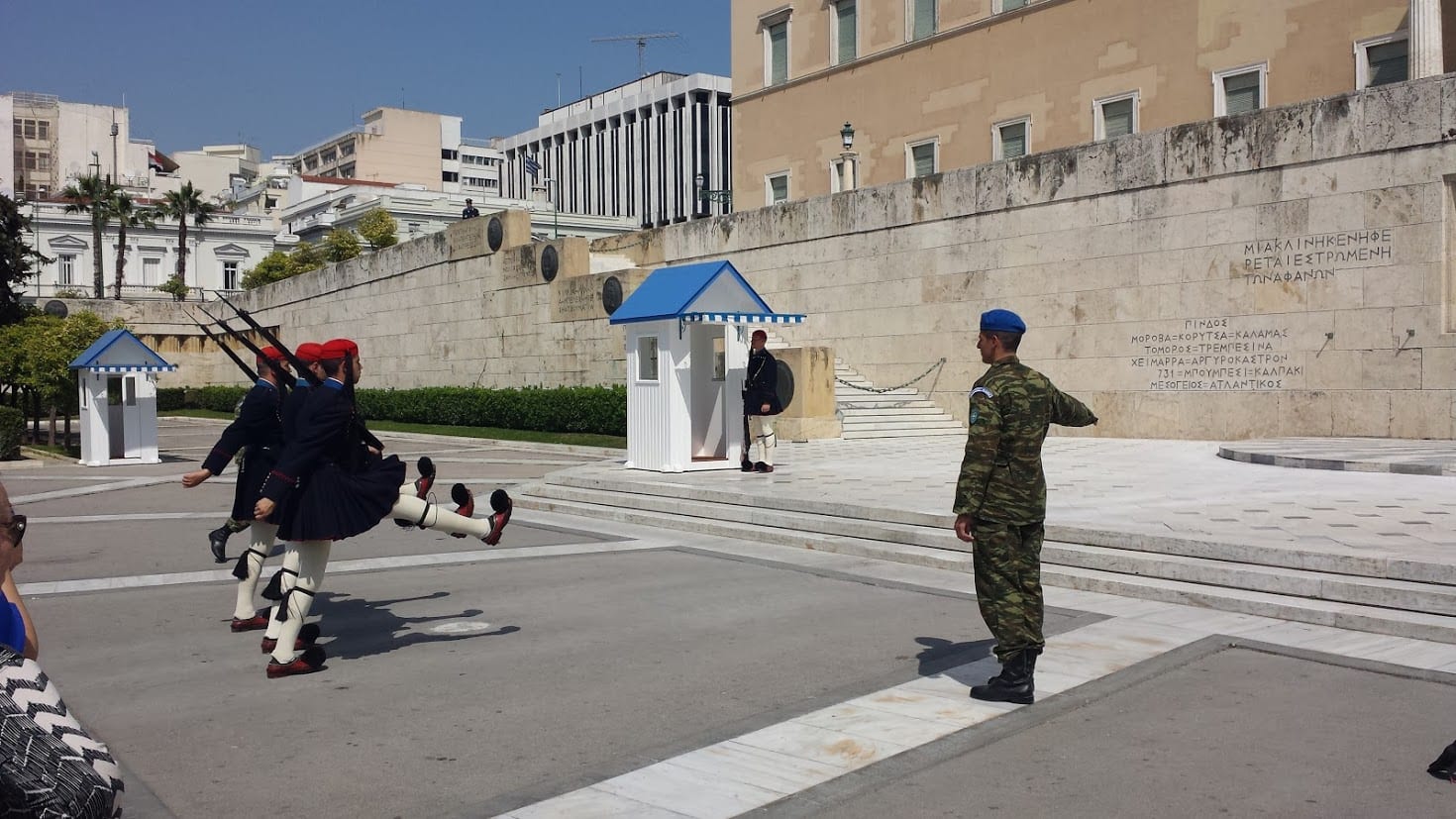
Right in front of the Parliament, you will see one of the lesser acknowledged monuments of Athens, the Tomb of the Unknown Soldier. This cenotaph (=empty tomb) is dedicated to all the soldiers who fought for Greece. It was constructed in the 1930s, and is guarded by the Evzones, an elite team of young men serving in the military.
You will immediately notice the body of a dead soldier with a helmet and shield. On the wall, there are names of places where certain battles took place. There is also a famous phrase by Thucydides, roughly translating to “The whole earth is the sepulchre of famous men”.

The Change of the Guards in front of the Tomb of the Unknown Soldier has a significant cultural meaning, as the Guards pay their respect to their ancestors.
The hourly Changing ceremony is a popular tourist attraction. When you visit, be respectful, and follow the cues given by the Guard in military uniform.
The Athens Trilogy
A few minutes’ walk from the Parliament, just outside Panepistimio metro, you can see three stunning Athens monuments. These neoclassical buildings, dating from the late 19th century, are known as the Athens Trilogy.
Three prominent architects of the time, Christian Hansen, Theophilos Hansen, and Ernst Ziller, were involved in their design and construction.

These three monuments in Athens Greece were based on designs after Ancient Greek temples. Walk around the gardens, and observe the columns, bright colours and statues.
The building on the left is the National Library. It was operating from 1903 until 2019, when most of the books were transferred to their new bigger home, the Stavros Niarchos Foundation.
The other two buildings are the University of Athens and the Academy of Athens, currently used for selected events. Occasionally, it is possible to visit the University of Athens.
Panagia Kapnikarea church
There are hundreds of Byzantine churches all around Greece. Few, however, are as iconic as the Panagia Kapnikarea church.
Located right in the middle of the main shopping street in Athens, Ermou pedestrian street, this landmark church was built in the 11th century AD.

It was dedicated to Panagia, the Virgin Mary. It was likely built on an older church, which in turn had been built on the site of an ancient temple, dedicated to one of the goddesses Athena or Dimitra.
Parts of the church were destroyed during the Ottoman rule. After the Greek revolution in 1821, the church was almost demolished in order to facilitate the construction of Ermou street. Fortunately, it was decided to keep it in place.
If you visit the church, take a moment to explore the different architectural styles. Some of the columns are well over 1,000 years old. As for the frescoes, they were made by the prominent iconographer Fotis Kontoglou and his students.
This video explains more about the stunning Kapnikarea church. It’s well worth watching!
Bonus – The Temple of Poseidon at Sounion
Technically speaking, the Temple of Poseidon at Sounion is not in the city of Athens. Yet, the list of Athens famous landmarks wouldn’t be complete without it!
Visiting the temple of Poseidon at Cape Sounion is a popular half-day trip from Athens. Sounion is about 70 kms out of the city, right at the tip of the Attica peninsula where the city of Athens is located.
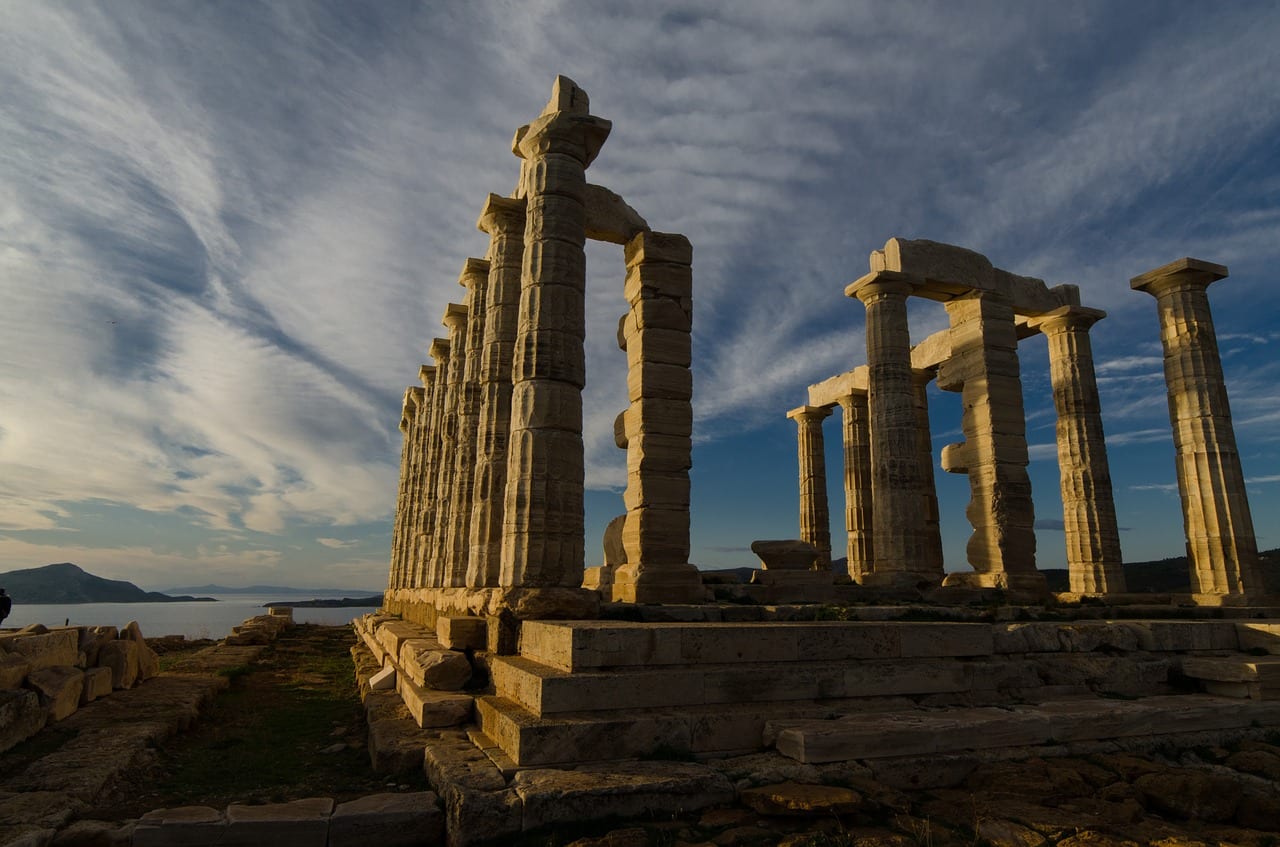
The coastal road leading to the temple, often referred to as “the Athens Riviera”, is a beautiful route. It passes by some of the most privileged areas in wider Athens, like Glyfada, Voula and Vouliagmeni. To your right, you will enjoy the deep blue sea.
The archaeological site itself was one of the most important places in Athens in ancient times. Dedicated to Poseidon, the temple offers spectacular views of the Aegean. Its location, close to ancient Lavrion with the silver mines, was absolutely fit for the god of the sea.
Take your time to walk around the whole site. Walk down the hill, and you will be rewarded with fantastic sunset views at one of the most important Athens historical sites!
Bonus 2 – The ancient site of Vravrona (Brauron)
Not many people thinking of ancient ruins in Athens Greece have heard of the sanctuary of Artemis in Vravrona, or Brauron. Yet, this lesser known archaeological site is absolutely worth the half-day trip.

Located 33 kms out of central Athens, Ancient Vravrona reached its peak roughly during the era of Classical Athens, between 500 and 300 BC. Goddess Artemis was, among others, the protectress of girls who hadn’t reached puberty. The young girls stayed in the temple and took part in highly symbolic rituals, where bear skins were originally used.
The location of the site is fantastic, as the nature is wild and it’s very close to the coast. In addition, the museum is superb, and it sheds some more light on life during the ancient times.
The site itself is hard to reach by public transportation, so it’s best to either hire a car, or go on an organised tour. Here is some more information on Ancient Vravrona in Athens Greece.
Athens Greece Landmarks FAQ
Here are some frequently asked questions about historic landmarks in Athens, including famous ancient sites such as the Acropolis and lesser known Athens monuments.
What to do in Athens in 3 days?
3 days in Athens is enough time to see most of the major attractions and places of interest such as the Acropolis, Ancient Agora, Greek temples, historic center, streets of Plaka and much more! Check out my guide to 3 days in Athens for more details.
What is Athens famous for?
Athens is one of the oldest continuously inhabited cities in the world, and birthplace of the first known democracy in the world. During the height of its influence, Athens was a cultural powerhouse making advances in literature, philosophy, mathematics and science that still influence the world thousands of years later.
What should I not miss in Athens?
In addition to the obvious famous sites in Athens such as the Parthenon, you should make time to check out the local street art and food scenes. There's some stunning street art in Athens, and Greek cuisine is one of the most underrated in the world!
What is the best known ancient monument in Athens Greece?
By far the best known Athens landmark is the Acropolis of Athens. This imposing fortified rocky outcrop dominates the historic center of the city, and the Acropolis along with its buildings such as the Parthenon is a UNESCO World Heritage Site.
Landmarks Athens
If you enjoyed reading this post about Athens monuments and landmarks, please share it on social media.
You can find the sharing buttons in the button of your screen, and the image below would look great on your Athens and Greece boards on Pinterest!
Next read: What is Athens famous for?

 – Dave Briggs
– Dave Briggs
Dave is a travel writer who's been living in Athens for 6 years. During that time, he's visited all the main landmarks of Athens, creating travel blog posts like this to help other travelers. He has a somewhat ambitious goal of visiting every Greek island (there's over 200!) and writing about them all.
Follow Dave on social media for travel inspiration from Greece and beyond: Facebook, Twitter, Pinterest, Instagram, YouTube.